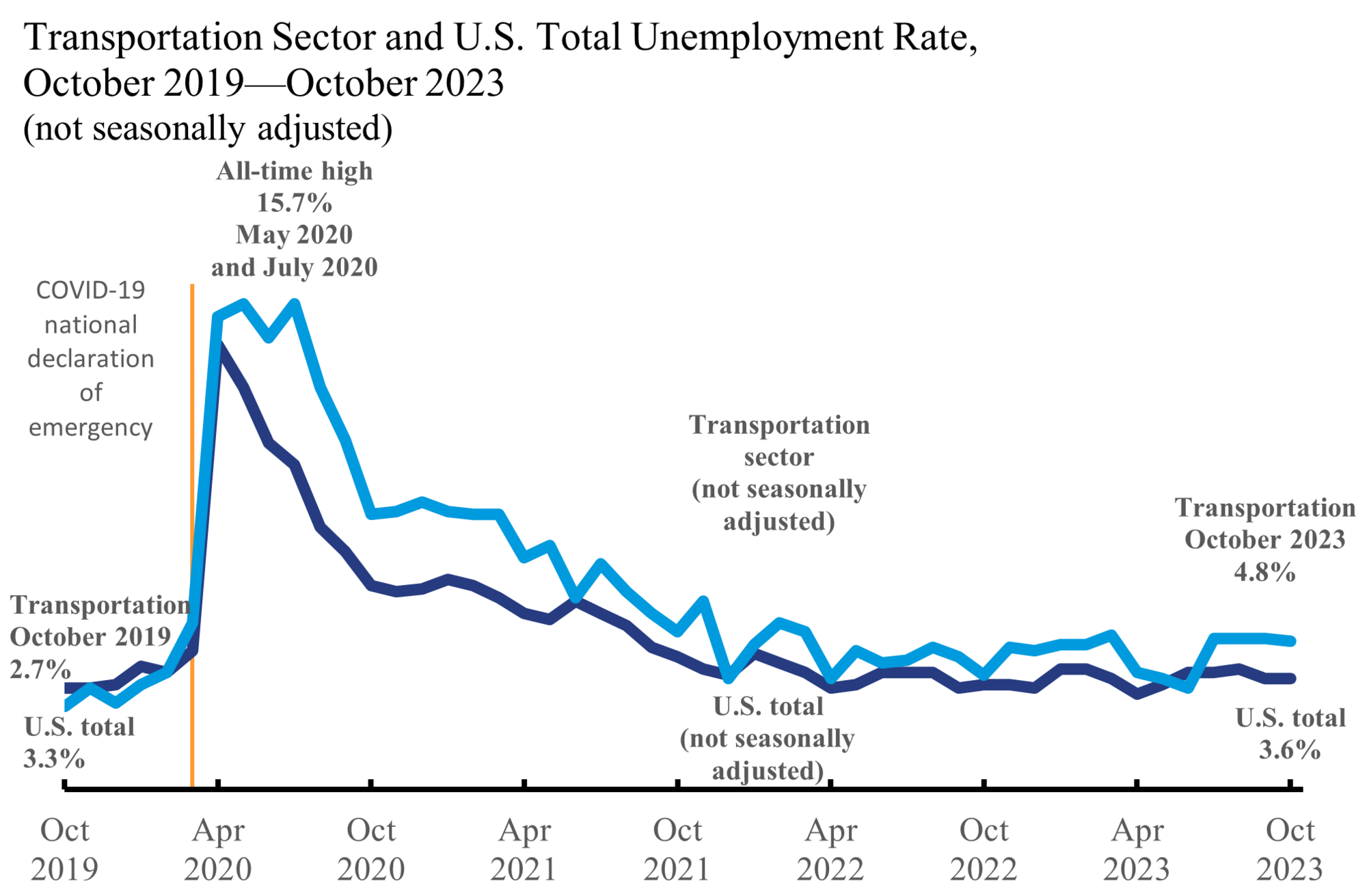October 2023 U.S. Transportation Sector Unemployment (4.8%) Rises Above the October 2022 Level (3.7%) And the Pre-Pandemic October 2019 Level (2.7%)
U.S. Department of Transportation sent this bulletin at 11/03/2023 11:40 AM EDT |
|
Having trouble viewing this email? View it as a Web page. |
October 2023 U.S. Transportation Sector Unemployment (4.8%) Rises Above the October 2022 Level (3.7%) And the Pre-Pandemic October 2019 Level (2.7%)

The unemployment rate in the U.S. transportation sector was 4.8% (not seasonally adjusted) in October 2023 according to Bureau of Labor Statistics (BLS). These data have been updated on the Bureau of Transportation Statistics’ (BTS) Unemployment in Transportation dashboard. In October 2023, the transportation sector unemployment rate rose 1.1 percentage points from 3.7% in October 2022 and was above the pre-pandemic October 2019 level of 2.7% but still below the October 2020 and October 2021 rates. Unemployment in the transportation sector reached its highest level during the COVID-19 pandemic (15.7%) in May 2020 and July 2020.
Unemployment in the transportation sector was higher than overall unemployment. BLS reports that the U.S. unemployment rate, not seasonally adjusted, in October 2023 was 3.6% or 1.2 percentage points below the transportation sector rate. Seasonally adjusted, the U.S. unemployment rate in October 2023 was 3.9%.

Seasonally adjusted, employment in the transportation and warehousing sector fell to 6,686,200 in October 2023 — down 0.2% from the previous month and down 0.8% from October 2022. Employment in transportation and warehousing grew 16.9% in October 2023 from the pre-pandemic October 2019 level of 5,717,900. By mode (seasonally adjusted):
- Air transportation rose to 555,100 in October 2023 — up 0.6% from the previous month and up 7.4% from October 2022.
- Truck transportation fell to 1,578,600 in October 2023 — down 0.3% from the previous month and down 1.7% from October 2022.
- Transit and ground passenger transportation fell to 434,200 in October 2023 — down 0.2% from the previous month but up 4.1% from October 2022.
- Rail transportation remained virtually unchanged in October 2023 at 150,200 from the previous month but up 1.8% from October 2022.
- Water transportation rose to 70,300 in October 2023 — up 1.7% from the previous month and up 6.2% from October 2022.
- Pipeline transportation fell to 48,000 in October 2023 — down 1.0% from the previous month and down 0.2% from October 2022.
- Warehousing and storage fell to 1,871,000 in October 2023 — down 0.6% from the previous month and down 4.0% from October 2022.

NOTES: October 2019 and October 2023 employment (seasonally adjusted) not shown for water (67,900 and 70,300, respectively) or pipeline (51,700 and 48,000, respectively) transportation. All-time highs (seasonally adjusted) with records beginning in 1990: air March 2001 (633,600); pipeline July 1991 (61,200); rail January 1990 (278,100); transit June 2019 (503,800); truck January 2023 (1,611,400); warehousing and storage June 2022 (1,960,300); and water October 2023 (70,300)
In addition to updating the Unemployment in Transportation and the Employment in Transportation: Total, by Mode, and Women dashboards, BTS also updated the Race and Hispanic or Latino Ethnicity of Transportation Workers dashboard.
Charts updated this month by section include:
Unemployment in the Transportation and Warehousing Sector and in Transportation and Material Moving Occupations
Monthly Employment in the Transportation and Warehousing Sector, Establishment Data
- Monthly Employment in the Transportation and Warehousing Sector
- Monthly Employment in the Transportation and Warehousing Sector by Mode
- Women Workers in the Transportation and Warehousing Sector
Monthly Employment in the Transportation and Warehousing Sector by Race and Hispanic or Latino Ethnicity, Household Data
Visit Transportation Economic Trends for more topics.
The unemployment rate is the total number of unemployed persons, expressed as a percentage of the civilian labor force. The civilian labor force includes all persons aged 16 and older who are employed and unemployed; meaning they are either currently working or actively looking for work. Unemployed persons include those who actively sought a job within the last four weeks. People waiting to start a new job who have not actively sought a job in the last four weeks are not counted as employed or unemployed; they are considered to be out of the labor force.
An unemployed person’s industry is the industry for the last job they held in the workforce, which may or may not reflect their current job search field or industry.
